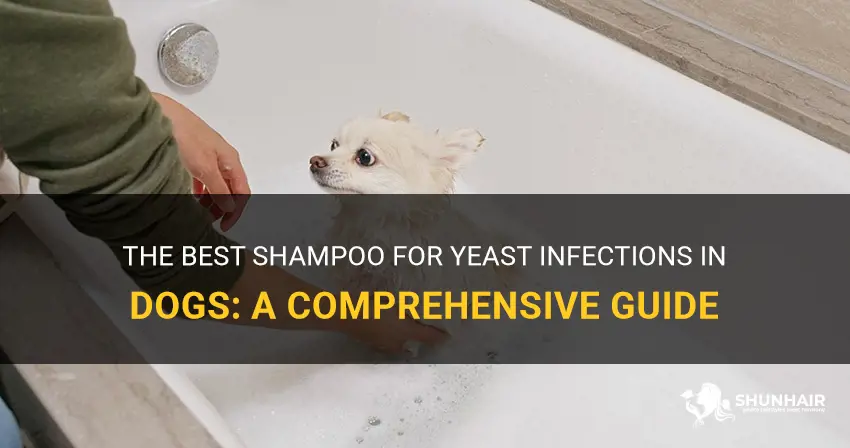
If you've ever had a dog with a yeast infection, you know just how uncomfortable and irritating it can be for them. One of the simplest and most effective ways to treat this common issue is by using a dog shampoo specifically formulated to target yeast. But with so many options on the market, it can be challenging to determine which one is truly the best. In this article, we'll explore some of the top dog shampoos for yeast infections, discussing their unique properties and why they may be the perfect solution for your furry friend.
| Characteristics | Values |
|---|---|
| Active ingredients | Antifungal properties |
| pH level | Neutral or slightly acidic |
| Aloe vera or oatmeal | Soothing ingredients |
| Tear-free formula | Gentle on the eyes |
| Hypoallergenic formula | Suitable for sensitive skin |
| Moisturizing properties | Helps prevent dryness |
| Antibacterial properties | Helps prevent bacterial infections |
| Natural or organic ingredients | Free from harsh chemicals |
| Scent | Pleasant and non-irritating |
| Veterinary recommended | Trusted by professionals |
What You'll Learn
- What ingredients should I look for in a dog shampoo that is best for treating yeast infections?
- Are there any specific brands or products that veterinarians recommend for treating yeast infections in dogs?
- How often should I bathe my dog with a specific yeast infection shampoo?
- Can using a specific shampoo alone effectively treat a yeast infection, or are other treatments necessary?
- Are there any potential side effects or risks associated with using a yeast infection shampoo on my dog?

What ingredients should I look for in a dog shampoo that is best for treating yeast infections?
Yeast infections are a common problem in dogs, especially in warm and humid environments. These infections can cause discomfort for your four-legged friend and can lead to other health issues if not properly treated. One effective way to treat yeast infections in dogs is by using a specially formulated dog shampoo. However, with so many options available on the market, it can be overwhelming to know which ingredients to look for in a dog shampoo that is best for treating yeast infections. In this article, we will discuss the key ingredients to consider when choosing a dog shampoo for yeast infections.
- Antifungal Agents: The most important ingredient in a dog shampoo for yeast infections is an antifungal agent. Look for shampoos that contain ingredients such as ketoconazole or miconazole. These ingredients work by inhibiting the growth of yeast and other fungi, helping to eliminate the infection. It's important to note that while these ingredients are effective, they should be used under the guidance of a veterinarian to ensure proper dosage and usage.
- Natural Antiseptics: Many dog shampoos for yeast infections also contain natural antiseptics that help soothe the skin and promote healing. Ingredients such as tea tree oil, aloe vera, and chamomile have natural antimicrobial properties and can help reduce inflammation and irritation caused by the yeast infection. These ingredients can also help moisturize and restore the skin's natural balance, which is essential for preventing future infections.
- PH-Balanced Formulas: Dogs have a different pH level than humans, so it's important to choose a dog shampoo that is specifically formulated for their needs. Look for shampoos that are pH-balanced, as this will help maintain the natural acidity of your dog's skin. When the skin's pH level is imbalanced, it can create an environment that is more susceptible to yeast infections. By using a pH-balanced shampoo, you can help restore and maintain your dog's skin health.
- Gentle and Hypoallergenic Formulas: Dogs with yeast infections often have sensitive and inflamed skin. Therefore, it's crucial to choose a shampoo that is gentle and hypoallergenic. Harsh chemicals and fragrances can further irritate the skin and worsen the infection. Opt for shampoos that are free from artificial colors, fragrances, and sulfates. These gentle formulas will help cleanse the skin without causing further irritation, allowing the antifungal and healing ingredients to work effectively.
- Conditioning Ingredients: Yeast infections can leave the skin dry, flaky, and itchy. Choosing a dog shampoo that contains conditioning ingredients can help alleviate these symptoms and promote overall skin health. Look for ingredients such as oatmeal, coconut oil, or shea butter, as these can help moisturize and nourish the skin. Conditioning ingredients can also help repair the skin's natural barrier, preventing future infections.
When dealing with a yeast infection in your dog, it's essential to seek veterinary advice and follow their recommended treatment plan. A dog shampoo can be a valuable tool in the treatment process, but it's crucial to choose one with the right ingredients. By selecting a dog shampoo that contains antifungal agents, natural antiseptics, pH-balanced and hypoallergenic formulas, as well as conditioning ingredients, you can help effectively treat your dog's yeast infection and improve their overall skin health. Always remember to consult with your veterinarian before starting any treatment regimen, as they can provide personalized recommendations based on your dog's specific needs.
Is It Safe to Put WD-40 in Your Hair?
You may want to see also

Are there any specific brands or products that veterinarians recommend for treating yeast infections in dogs?
Yeast infections in dogs can be a common occurrence, especially in dogs with certain predisposing factors such as allergies, weakened immune systems, or skin folds. These infections can cause discomfort and irritation for the dog, and may require treatment to alleviate the symptoms and prevent further complications.
When it comes to treating yeast infections in dogs, veterinarians typically recommend a multifaceted approach that involves both topical and oral medications. While there are several over-the-counter treatments available, it is always best to consult with a veterinarian for a proper diagnosis and treatment plan.
One of the most commonly recommended topical treatments for yeast infections in dogs is a medicated shampoo or rinse. These products typically contain antifungal medications such as ketoconazole or miconazole, which can help to effectively kill the yeast on the skin. Examples of popular medicated shampoos for yeast infections in dogs include Malaseb, Ketohex, and Douxo. These products are often used in conjunction with other treatments and may need to be used regularly to keep the yeast under control.
In addition to medicated shampoos, veterinarians may also prescribe topical creams or ointments to treat yeast infections in dogs. These products are typically applied directly to the affected areas and often contain antifungal medications such as clotrimazole or terbinafine. Examples of prescription topical treatments for yeast infections in dogs include Animax, Otomax, and Panolog. These products are usually used for a designated period of time until the infection clears up.
Along with topical treatments, veterinarians may also recommend oral medications to treat yeast infections in dogs. Antifungal medications such as fluconazole or itraconazole may be prescribed to help eliminate the yeast from within the dog's body. These medications are typically given daily for a specified period of time and may require regular check-ups with the veterinarian to monitor the dog's progress. Examples of oral medications for yeast infections in dogs include Diflucan, Sporanox, and Nizoral.
It is important to note that the specific brand or product recommended by a veterinarian may vary depending on the individual dog and the severity of the infection. Some dogs may require a combination of different treatments, while others may only need one or two.
In addition to medication, veterinarians may also recommend certain dietary changes to help manage yeast infections in dogs. Yeast thrives on sugar, so reducing the dog's intake of carbohydrates and sugars can be beneficial. Feeding a high-quality, grain-free diet that is rich in healthy proteins and fats may help to support the dog's immune system and promote overall skin health.
Furthermore, it is important to address any underlying causes of yeast infections in dogs. For example, dogs with allergies may require allergy testing and management, while dogs with compromised immune systems may need additional supplements or medications to support their immune function.
In conclusion, there are several brands and products available for treating yeast infections in dogs, but it is always best to consult with a veterinarian for a proper diagnosis and treatment plan. Veterinarians may recommend a combination of topical and oral medications, as well as dietary changes and addressing any underlying causes. By following the veterinarian's advice and using the recommended treatments, it is possible to effectively manage and treat yeast infections in dogs and improve their overall health and well-being.
Exploring the Benefits of Using Baby Shampoo for Maintaining a Healthy Lawn
You may want to see also

How often should I bathe my dog with a specific yeast infection shampoo?
As a responsible dog owner, it is important to ensure that your furry friend stays clean and healthy. If your dog is suffering from a yeast infection, regular bathing with a specific yeast infection shampoo can help alleviate the problem. But how often should you bathe your dog with this shampoo? Let's delve into this topic and find out.
Yeast infections in dogs can cause itchiness, redness, and a foul odor. They are usually caused by an overgrowth of yeast on the skin, which can be a result of various factors such as allergies, a compromised immune system, or a hormonal imbalance.
When it comes to bathing your dog with a yeast infection shampoo, the frequency will depend on the severity of the infection and the recommendation of your veterinarian. In mild cases, bathing once a week may be sufficient to help control the yeast overgrowth. However, for more severe infections, your vet may recommend bathing your dog with the specific shampoo two to three times a week.
It is important to note that over-bathing your dog can strip the skin of its natural oils, leading to dryness and irritation. On the other hand, under-bathing can allow the yeast to thrive and worsen the infection. Therefore, it is essential to strike the right balance.
Here are some steps to follow when bathing your dog with a specific yeast infection shampoo:
- Consult your veterinarian: Before starting any treatment, it is crucial to consult your vet. They will examine your dog and determine the severity of the infection, as well as provide specific guidance on the frequency of bathing.
- Gather the necessary supplies: Make sure you have all the necessary supplies ready before bathing your dog. This includes the yeast infection shampoo, towels, a brush or comb, and treats to reward your dog for good behavior.
- Wet your dog: Start by wetting your dog with lukewarm water. Avoid using hot water as it can irritate the skin. Thoroughly wet the affected areas where the yeast infection is present.
- Apply the shampoo: Take a small amount of the yeast infection shampoo and lather it into your dog's coat, focusing on the affected areas. Use gentle circular motions to distribute the shampoo evenly. Be careful not to get the shampoo into your dog's eyes or nose.
- Rinse thoroughly: Rinse your dog's coat thoroughly to remove all traces of the shampoo. Make sure to rinse the affected areas particularly well.
- Dry your dog: Gently pat your dog dry with a towel. Avoid rubbing vigorously, as this can further irritate the skin. If your dog has long hair, you may use a low heat setting on a hairdryer to speed up the drying process.
- Follow-up treatments: Depending on the severity of the infection, your vet may recommend additional treatments, such as topical creams or oral medications. Follow their instructions carefully to ensure the best results.
Remember, bathing your dog with a yeast infection shampoo is just one part of the overall treatment plan. It is important to address the underlying causes of the infection, such as allergies or a compromised immune system, to prevent future yeast overgrowth.
In conclusion, the frequency of bathing your dog with a specific yeast infection shampoo will depend on the severity of the infection and the recommendation of your veterinarian. Follow their guidance and maintain a balance between keeping your dog clean and not over-bathing. With the right treatment and care, you can help your furry friend overcome their yeast infection and maintain optimal skin health.
Rejuvenate Your Hair with These Post-Swimming Treatments
You may want to see also

Can using a specific shampoo alone effectively treat a yeast infection, or are other treatments necessary?
A yeast infection is a common condition that occurs when there is an overgrowth of yeast in the body. While yeast infections can occur in various parts of the body, such as the mouth, throat, and skin, one of the most common types of yeast infections is a vaginal yeast infection. Many people wonder if using a specific shampoo alone can effectively treat a yeast infection, or if other treatments are necessary. In this article, we will explore this topic and provide you with the necessary information to make an informed decision.
Firstly, it is important to understand that yeast infections are typically caused by a type of fungus known as Candida. Candida is naturally present in the body and is usually harmless. However, certain factors can lead to an overgrowth of Candida, resulting in a yeast infection. These factors can include hormonal changes, a weakened immune system, certain medications, and high levels of sugar in the body.
While specific shampoos may be advertised as effective for treating yeast infections, it is important to note that yeast infections typically require a multifaceted approach for successful treatment. Using a shampoo alone may not be sufficient to eliminate the infection completely.
When it comes to treating a vaginal yeast infection, the gold standard treatment involves antifungal medications. These medications can be obtained over the counter or prescribed by a healthcare professional. Antifungal medications work by killing the yeast and relieving the symptoms associated with the infection. It is essential to follow the instructions provided by the medication and complete the full course of treatment for the best results.
Additionally, there are several lifestyle changes and self-care measures that can help to prevent and manage yeast infections. These include:
- Maintaining good hygiene: This involves regularly cleaning the affected area with mild soap and water. Avoid using harsh soaps or douches, as they can disrupt the natural balance of bacteria and yeast in the body.
- Wearing loose-fitting clothing: Tight clothing can create a warm and moist environment, which promotes the growth of Candida. Opt for breathable fabrics, such as cotton, and avoid synthetic materials.
- Avoiding irritants: Certain products, such as scented tampons, pads, and douches, can irritate the vaginal area and increase the risk of a yeast infection. It is best to avoid these products and opt for unscented alternatives.
- Managing blood sugar levels: People with diabetes or high blood sugar levels are more prone to yeast infections. It is crucial to manage blood sugar levels through a healthy diet, exercise, and medication if necessary.
- Probiotics: Probiotics are beneficial bacteria that help maintain a healthy balance of bacteria and yeast in the body. Consuming probiotic-rich foods and supplements may help prevent or manage yeast infections.
In summary, while using a specific shampoo may provide temporary relief for the symptoms of a yeast infection, it is unlikely to effectively treat the infection on its own. Antifungal medications are the most effective treatment for yeast infections and should be used as directed by a healthcare professional. Additionally, adopting good hygiene practices, wearing loose-fitting clothing, avoiding irritants, managing blood sugar levels, and incorporating probiotics into your diet can help prevent and manage yeast infections. It is always best to consult with a healthcare professional for an accurate diagnosis and appropriate treatment plan.
Affordable Shampoos: The Best Options for a Budget-Friendly Haircare Routine
You may want to see also

Are there any potential side effects or risks associated with using a yeast infection shampoo on my dog?
Yeast infections are a common problem in dogs, and they can cause a range of uncomfortable symptoms such as itching, redness, and irritation. One popular treatment option for yeast infections in dogs is a yeast infection shampoo. These shampoos are specially formulated to help kill the yeast and alleviate the associated symptoms. However, like any medication or treatment, there are potential side effects and risks to consider.
One potential side effect of using a yeast infection shampoo on your dog is skin irritation. Some dogs may have a sensitivity or allergy to the ingredients in the shampoo, which can lead to redness, itching, and discomfort. It's important to carefully read the label and choose a shampoo that is specifically designed for dogs, as human shampoos can be too harsh and cause further irritation.
Another potential risk of using yeast infection shampoo is overdosing. Some shampoos contain antifungal medications such as ketoconazole, which can be toxic if ingested in large quantities. It's important to follow the recommended dosage and not allow your dog to ingest the shampoo. If you notice any signs of overdose such as vomiting, diarrhea, or lethargy, it's important to contact your veterinarian immediately.
Additionally, using a yeast infection shampoo may not address the underlying cause of the yeast infection. Yeast infections in dogs can be caused by a variety of factors, including allergies, a weakened immune system, or an underlying medical condition. If the shampoo is not addressing the root cause of the infection, the symptoms may return or worsen over time. It's important to consult with your veterinarian to determine the underlying cause and develop a comprehensive treatment plan.
When using a yeast infection shampoo on your dog, it's important to follow the instructions carefully and use it as directed. Avoid getting the shampoo in their eyes or ears, as this can cause irritation. It's also important to thoroughly rinse the shampoo off, as leaving residue on the skin can further irritate the area. After the bath, make sure to dry your dog thoroughly, as moisture can promote the growth of yeast.
While yeast infection shampoos can be an effective treatment for yeast infections in dogs, it's important to be aware of the potential side effects and risks. If you have any concerns or notice any adverse reactions in your dog, it's important to consult with your veterinarian. They can provide guidance on the best treatment options for your dog's specific needs and monitor their progress to ensure a full recovery.
Understanding the Effectiveness of Ketoconazole Shampoo for Dandruff Relief
You may want to see also







